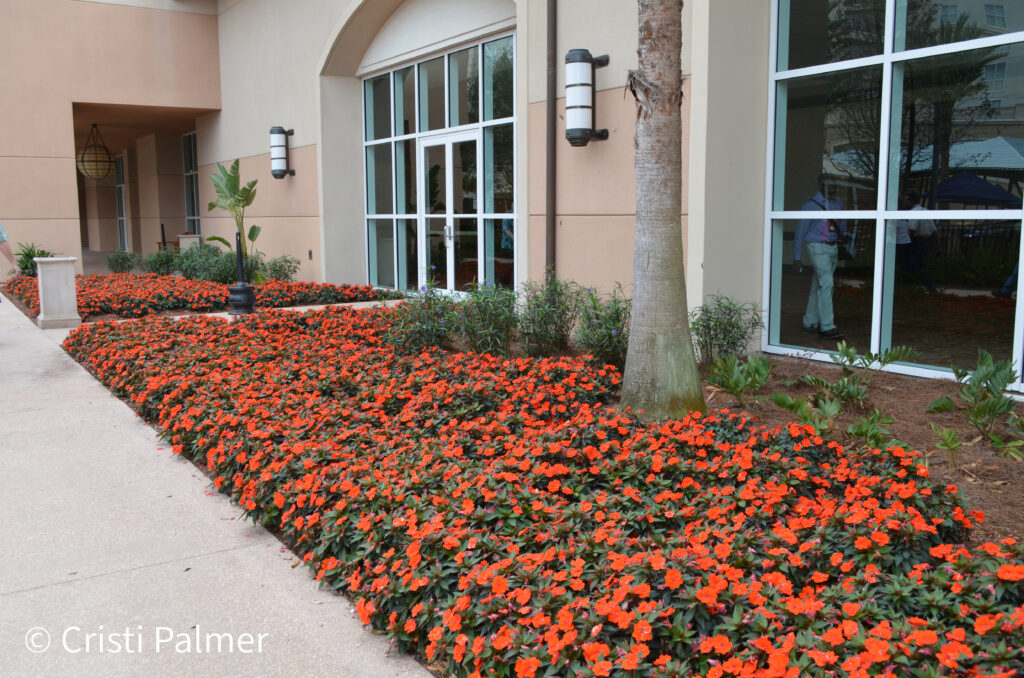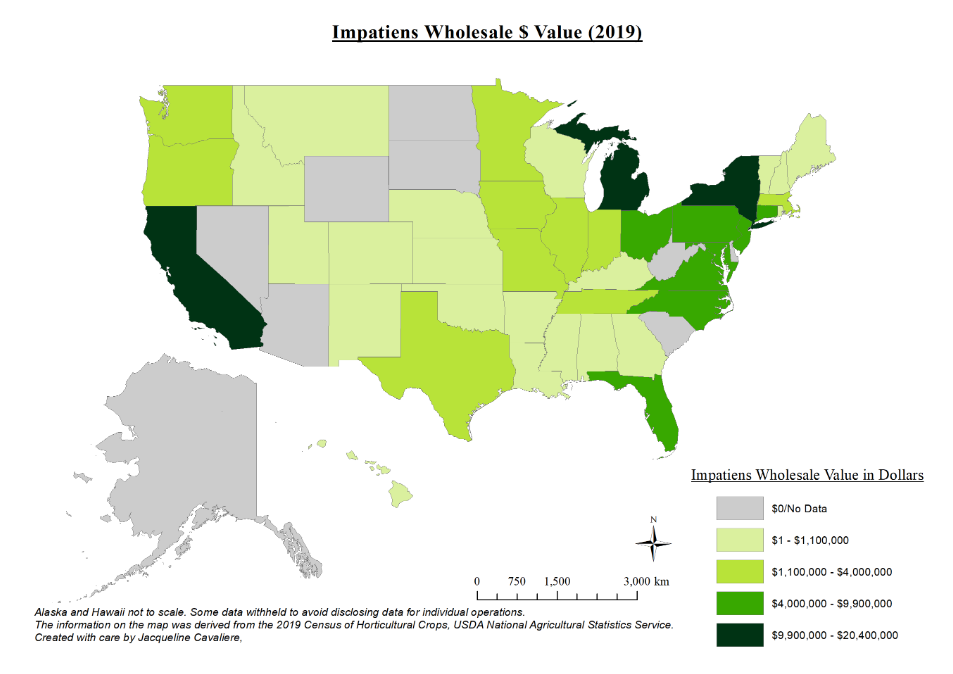Plant Information
Impatiens is a genus of more than 1,000 flowering plants in the family Balsaminaceae widely distributed throughout the Northern Hemisphere and the tropics. Most Impatiens species occur in the tropical and subtropical mountain forests in Africa, Madagascar, the Himalayas, the Western Ghats (southwest India), and Southeast Asia. Two species (I. turrialbana and I. mexicana) occur in isolated areas in Central America (southern Mexico and Costa Rica). In Europe, only a single Impatiens species (I. noli-tangere) occurs naturally. The two most popular species in the United States and worldwide are I. walleriana, a native of East Africa, and I. hawkerii, a native of New Guinea. There are several neophytic species including the garden balsam (I. balsamina), native to the tropics of Asia but has long been cultivated in temperate regions of the world, spotted jewelweed (I. capensis), and pale touch-me-not (I. pallida), which are common weeds native to extensive regions of eastern North America.
Impatiens plants are one of the most popular annual flowers, due to their brightly colored blooms and their ability to grow in shady areas. Although technically tropical perennials, these plants are grown as annuals in all but the warmest regions (zones 10 to 12). Impatiens walleriana, commonly called buzzy lizzy, is considered the most popular impatiens. The most commonly grown cultivars are short plants, attaining a height of not more than 1 foot. Some types, such as the ‘Super Elfin’ series, stay much shorter. Standard impatiens flowers come in a variety of colors, including white, red, pink, violet, coral, purple, and (a relative newcomer) yellow. Common impatiens flowers have much to offer, including shade-tolerance, long-lasting blooms, and brightly colored blossoms that come in a variety of colors. Impatiens flowers have long been one of the dominant bedding plants in North America, especially for shaded areas. They are also used in container gardens, ranging from hanging baskets to window boxes. The other common form of impatiens is the New Guinea impatiens (I. hawkeri). It is a notably larger plant than standard impatiens and is considered to be showier, especially in terms of its foliage. New Guineas can also take a little more sunshine than can I. walleriana. Many growers prefer the New Guinea type for use in containers. In recent years, perhaps the biggest advantage of the New Guinea type is its resistance to downy mildew. There are more than a thousand varieties of impatiens. Standard impatiens may still be hard to find since mildew-resistant varieties are still being developed and introduced. The best selection may come with New Guinea impatiens. Some recommended varieties of buzzy lizzy and New Guinea impatiens include: ‘Imara XDR’, ‘Beacon’ ‘Celebration’, ‘Bounce’ and SunPatiens’. A third, less popular impatiens is I. balsamina, a dwarf variety also called the Tom Thumb series.
Impatiens are easy to grow in any moist, well-drained soil enriched with organic matter in a shady or semi-shady location. If planted in containers, like window boxes, a sterile or soil-less growing mixture to ensure better drainage for the plants should be used. New Guinea impatiens will tolerate more sun than do standard buzzy lizzy impatiens. In northern United States and areas with similarly cold winters, the traditional time for planting impatiens is Memorial Day, when the danger of frost has passed. After planting, pinching back the stems will encourage bushier growth. Once in the ground, the impatiens will need at least two inches of water a week. When temperatures average consistently above 80 degrees, water at least 4 inches weekly. In window boxes and hanging pots, impatiens may need watering daily. If temperatures rise above 85 degrees, they will require at least 4 inches of water per week; they will need daily watering, or twice daily. Impatiens will flower best if regularly fertilized. A water-soluble fertilizer can be used every two weeks throughout the spring and summer. Another option is a slow-release fertilizer used at the beginning of the spring and again halfway through the summer.
Economics
According to the USDA NASS Census of Horticulture, sales for I. walleriana was $91.1M, I. hawkerii sold for $81.6M, and interspecific hybrids sold for $20.8M, for a total wholesale impatiens sales value of $193.4M in 2019.
 Main Disease Problems
Main Disease Problems
Impatiens have several disease problems, with the downy mildew (Plasmopara destructor) the most devastating one for buzzy lizzy impatiens. Other common diseases include Alternaria leaf spot (Alternaria sp.), botrytis blight/gray mold (Botrytis cinerea), bacterial fasciation (Corynebacterium fascians), damping-off (Pythium spp. or Rhizoctonia spp.), powdery mildew (Oidium sp. in New Guinea impatiens), Pythium root rot (Pythium spp.), Thielaviopsis root rot (T. basicola), Verticillium wilt (V. dahlia) and viruses (impatiens necrotic spot virus and tomato spotted wilt virus). Nematodes (Meloidogyne incognita, Aphelenchoides fragariae, etc.) also attack impatiens.
Main Pest Problems
Common pests of impatiens include the melon aphid (Aphis gossypii), two-spotted spider mites (Tetranychus urticae), broad mite (Polyphagotarsonemus latus), cyclamen mite (Phytonemus pallidus), leafminers (Lyriomyza spp.), citrus mealybug (Planococcus citri), western flower thrips (Frankliniella occidentalis), black vine weevil (Otiorhynchus sulcatus), tarnished plant bug (Lygus lineolaris) and cutworms (Agrotis spp.). Slugs and snails also cause injury to impatiens.
IR-4 Research
IR-4 has sponsored 196 crop safety trials with 64 products, and we have screened 80 new actives with impatiens for effective management of damping-off (Rhizoctonia solani), downy mildew (Plasmopara obduscens/destructor), gray mold (Botrytis cinerea), leaf spot (Alternaria alternata), Pseudomonas blight (P. syringiae), Pythium root rot (P. irregulare), broad mite (Polyphagotarsonemus latus), melon aphid (Aphis gossypii), and western flower thrips (Frankliniella occidentalis). In addition, 7 new actives were studied for plant impact on impatiens.
Sources Cited
https://en.wikipedia.org/wiki/Impatiens
https://www.britannica.com/plant/Impatiens
https://www.cabi.org/isc/datasheet/28769
https://www.almanac.com/plant/impatiens
https://homeguides.sfgate.com/growing-impatiens-indoors-65894.html
https://extension.psu.edu/impatiens-diseases
https://homeguides.sfgate.com/diseases-insects-attack-impatiens-35296.html
http://ipm.ucanr.edu/PMG/GARDEN/FLOWERS/impatiens.html
https://texasinsects.tamu.edu/citrus-mealybug/
https://thepracticalplanter.com/impatiens-care/
USDA-NASS Census of Horticulture, 2019
Authors
Ely Vea, IR-4 Environmental Horticulture Program Assistant Manager and Jacqueline Cavaliere, IR-4 Environmental Horticulture Program Coordinator.


